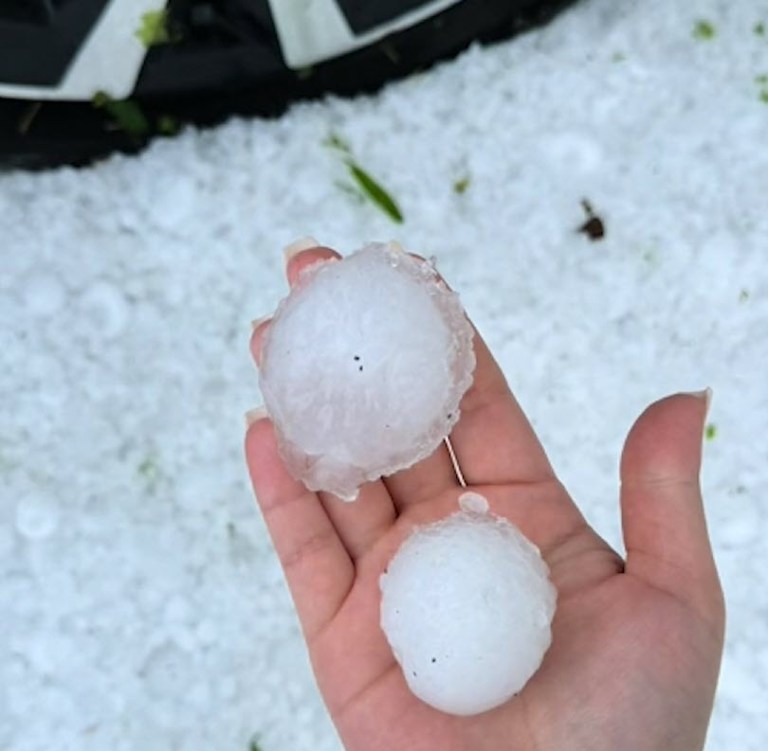Severe Hailstorms Cause Damage To Pools And Gardens

Table of Contents
Pool Damage from Severe Hailstorms
The force of a severe hailstorm can inflict significant damage on your pool and its surrounding features. Understanding the types of damage can help you assess the situation and take appropriate action.
Structural Damage
Hailstones, especially large ones, can cause considerable structural damage to your pool. The impact force can crack pool finishes, regardless of whether your pool is plastered, tiled, or lined with vinyl.
- Cracks in pool finishes: These cracks can lead to leaks and structural instability, requiring costly repairs.
- Chipped tiles: Hail can dislodge or chip tiles, compromising the aesthetic appeal and potentially leading to water loss.
- Broken coping stones: The coping stones surrounding your pool are particularly vulnerable to hail damage, potentially creating sharp edges and safety hazards.
- Damaged decking: Wooden or composite decking can suffer splintering, cracking, and even complete destruction from large hail.
The size and impact force of the hail directly correlate with the severity of the damage. Larger hailstones (greater than 1 inch in diameter) possess significantly more kinetic energy and cause more extensive damage. Ignoring structural damage can lead to long-term problems, including costly repairs, water loss, and even pool closure.
Equipment Damage
Pool equipment is also highly susceptible to hail damage. The impact of hailstones can damage critical components, leading to costly repairs or replacements.
- Dents in pump housings: Hail can dent or puncture pump housings, compromising their functionality and potentially causing leaks.
- Cracked filter tanks: Hailstones can crack filter tanks, leading to filter failure and water contamination.
- Damaged electrical components: Hail can damage electrical components, leading to short circuits and potential fire hazards.
The cost of repairing or replacing damaged pool equipment can be substantial. Investing in protective measures, such as covers for pumps and filters, can significantly mitigate this risk.
Water Contamination
Hailstorms often bring with them debris and contaminants that can contaminate your pool water.
- Leaves, branches, dirt, and other pollutants: Hail can drive these contaminants into the pool, significantly impacting water clarity and quality.
After a hailstorm, it is crucial to thoroughly clean and sanitize your pool. This may involve skimming the surface, vacuuming the bottom, and adding algaecide and clarifying agents to restore water clarity and prevent the growth of harmful bacteria and algae.
Garden Damage from Severe Hailstorms
Your garden is another area highly vulnerable to the destructive power of severe hailstorms. The damage can range from minor cosmetic issues to extensive destruction.
Plant Damage
Hail can cause various types of damage to plants, depending on the hail size and the type of plant.
- Bruised leaves: Smaller hail may simply bruise leaves, causing discoloration and hindering photosynthesis.
- Broken stems: Larger hailstones can break stems, particularly in delicate flowers and young plants.
- Damaged blossoms: Blossoms are especially vulnerable, leading to reduced fruit production or flower display.
- Torn foliage: Large hail can tear leaves and flowers, leaving plants unsightly and vulnerable to disease.
The long-term effects of hail damage can significantly impact plant health and yield, potentially resulting in reduced harvests or even plant death. Damaged plants become more susceptible to fungal infections and other diseases.
Landscape Damage
Beyond plant damage, severe hailstorms can impact other garden features.
- Damaged fences: Hail can damage fencing, creating gaps and compromising security.
- Broken garden ornaments: Fragile garden ornaments are easily shattered by hail.
- Destroyed sheds: Lightweight garden sheds can be severely damaged or even destroyed by large hail.
The cost of repairing or replacing these damaged landscape features can add up quickly.
Soil Erosion
Heavy hail can compact the soil and lead to erosion, disrupting plant root systems.
- Loss of topsoil: The impact of hail can dislodge topsoil, exposing plant roots and making them vulnerable.
- Damaged plant roots: Compacted soil can hinder root growth and reduce water and nutrient uptake.
Soil erosion reduces the soil's fertility, leading to stunted plant growth and reduced yields. Careful soil recovery techniques, such as adding organic matter and loosening compacted soil, may be needed after a hailstorm.
Insurance Claims for Severe Hailstorm Damage
Documenting and filing an insurance claim promptly is crucial to recovering from severe hail damage.
Documenting the Damage
Thorough documentation is essential for a successful insurance claim.
- Detailed photos: Take numerous detailed photos and videos showing the extent of the damage to both your pool and garden.
- Recording timestamps: Ensure that the photos and videos are timestamped to verify the timing of the damage.
- Contacting insurance company immediately: Report the damage to your insurance company as soon as possible after the hailstorm.
Filing an Insurance Claim
The insurance claim process may seem daunting, but following these steps will help streamline the procedure.
- Gathering necessary documents: Gather all relevant documents, including receipts for repairs, estimates from contractors, and any other supporting evidence.
- Understanding policy coverage: Review your insurance policy carefully to understand your coverage and the claim process.
- Following up on claim status: Follow up on the status of your claim regularly to ensure a timely resolution.
Conclusion
Severe hailstorms can cause devastating damage to pools and gardens, resulting in significant financial and emotional costs. Understanding the types of damage, documenting the impact thoroughly, and filing insurance claims promptly are crucial steps in recovery. Remember to take preventative measures like pool covers and storm shutters to mitigate future hail damage. Don't let severe hailstorms leave your pool and garden in ruins – be prepared! Investing in preventative measures and understanding your insurance coverage is key to protecting your valuable outdoor spaces from severe hail damage and minimizing the impact of future hail storm damage. Proper preparation and prompt action after a hailstorm are vital for minimizing the damage and ensuring a swift recovery.

Featured Posts
-
 Marvels Lost Henry Cavill Show Examining The Silver Lining
May 12, 2025
Marvels Lost Henry Cavill Show Examining The Silver Lining
May 12, 2025 -
 Doze D Economie Un Budget A Maitriser Des Defis A Relever
May 12, 2025
Doze D Economie Un Budget A Maitriser Des Defis A Relever
May 12, 2025 -
 End Of Refugee Excursions Fabers New Policy
May 12, 2025
End Of Refugee Excursions Fabers New Policy
May 12, 2025 -
 Pga Tours Zurich Classic Mc Ilroy And Lowry Commit To Title Defense
May 12, 2025
Pga Tours Zurich Classic Mc Ilroy And Lowry Commit To Title Defense
May 12, 2025 -
 Pritchards Historic Win Celtics Sixth Man Of The Year
May 12, 2025
Pritchards Historic Win Celtics Sixth Man Of The Year
May 12, 2025
